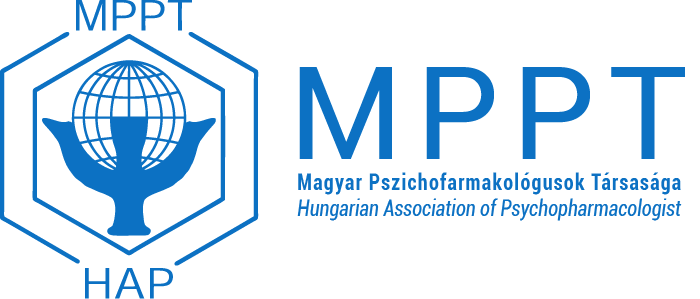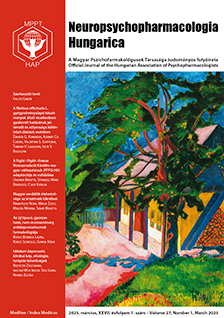Volume 27, Number 1, March 2025
Editoral in Hungarian
Gábor Faludi
Nature and severity of the effect of herbal medicinal products based on Melissa officinalis L. on animal behaviour when administrating different drug dosages
Zinada G. Khabaeva, Azamat Ch. Chiviev, Valentina S. Gappoeva, Tamara V. Lagkueva, Izeta V. Bugulova
Abstract
The purpose of this research is to study the impact of herbal medicinal products based on Melissa officinalis on the anxiolytic effect in animals at different dosages of the drug. The study was conducted on albino Wistar rats using a sequence of three behavioural test systems (black and white chamber, elevated cruciform maze and open field). The combined medicinal product included the following starting materials of herbal origin: Melissa officinalis, Origanum vulgare, Salvia officinalis, Crataegus berries and Glycyrrhiza glabra root, in the ratio 17:10:10:10:10. Two dosages of the drug were tested: 5 ml and 2.5 ml per 1 kg of animal weight. The active components of the starting materials of herbal origin were isolated through continuous extraction in the Soxhlet apparatus with ethyl alcohol; after that, the solvent was distilled in a rotary evaporator. The herbal preparation produced notable effects by alleviating stress caused by the experimental setup (reducing phobic reactions) and simultaneously enhancing locomotion as well as exploratory and searching activities. These effects were observed to varying degrees across all three behavioural models. A comparative analysis of the testing results at different dosages of the experimental herbal preparation demonstrated the comparability of quantitative changes in the recorded behavioural reactions. This data makes it possible to use a lower drug dosage (2.5 ml/kg) in subsequent studies. The developed complex herbal medicinal product can be used as a basis for creating phytopreparations with targeted anxiolytic effect. The experimental data obtained will subsequently help in choosing the optimal dosage for rational pharmacotherapy and prevention of psycho-emotional disorders in humans and animals.
(Neuropsychopharmacol Hung 2025; 27(1): 6–13)
Keywords: behavioural activity, albino laboratory rats, herbal medicinal product, complex herbal preparation, extract, anxiolytic activity
Adaptation and Validation of the Hungarian Version of the Fight–Flight–Freeze Questionnaire (FFFQ-HU)
Brigitta Ungvári, Márk Bendegúz Stranigg, Katalin Csigó
Abstract
Introduction: Fear is the primary emotional response to threats, driving individuals to cope with threats by triggering a stress response. This response can manifest in three distinct ways: defensive attack (fight), escape (flight), or immobility (freeze). Understanding these reaction types is crucial in personality psychology, neuroscience, and psychopathology. In this context, the adaptation of a Hungarian-language questionnaire to assess these responses is both timely and necessary.
Methodology: The aim of the present study is to adapt and validate the Fight-Flight-Freeze Questionnaire (FFFQ-HU) in Hungarian. The questionnaire development consisted of three phases: (1) a qualitative preliminary study to select terms describing the constructs, (2) a quantitative (N = 420) study to explore the preliminary factor structure and select the final items, and (3) a quantitative (N = 851) study to explore and confirm the final factor structure and validate it. The ZKA-PQ-R, ANPS, BIS-BAS, and TCI55 questionnaires were used as validation scales.
Results: Exploring the preliminary factor structure revealed clearly identifiable factors related to both the fight and freeze dimensions. In addition, we obtained one factor describing the emotional component of the fear response and one factor describing the avoidance behaviour, of which we retained the one containing the behavioural component for construct validity. The three-factor structure of the final questionnaire was confirmed, with acceptable or excellent fit indices for the exploratory analysis (RMSEA= 0.05; SRMR= 0.02; CFI= 0.97; TLI= 0.96), and also for the confirmatory one (RMSEA= 0.08; SRMR= 0.06; CFI= 0.97; TLI= 0.96, GFI= 0.99). The fight dimension did not correlate with the other factors, while flight and freeze showed a high positive correlation with each other, which differs from the results of the original questionnaire but can be explained by other research findings. The internal reliability indices of the factors were good (ω= 0.86-0.94; α= 0.86-0.94), and the correlation with the validation scales also supported the validity of the questionnaire.
Conclusion: The results suggest that the Hungarian version of the Fight-Flight-Freeze Questionnaire (FFFQ-HU) is an appropriate measure for assessing types of stress reactions, thus enabling a wider range of research on fear reactions in Hungarian in the future.
Keywords: stress response, fight-flight-freeze system, reinforcement sensitivity theory, questionnaire adaptation, Hungarian population
The quality of life of Hungarian adolescents in the light of their emotions
Nóra Rábavölgyi , Zsolt Mayer, Mónika Miklósi, Brigitta Szabó
Abstract
Objectives: Mental health professionals pay particular attention to adolescents, as many psychiatric disorders begin at this age, and the mental state of adolescents has been deteriorating worldwide in the last decade. Based on previous international research, the ability to regulate negative emotions and mentalization – that is, the ability to identify the thoughts and emotions behind one’s own and others’ behaviour – mediate the negative effects of attachment difficulties experienced in close relationships on the quality of life. This relationship has not yet been investigated among Hungarian adolescents. Adolescent events can have a long-term effect on a person’s mental health, so it is very important to examine the factors that influence the quality of life. This research aimed to examine the relationship between attachment, mentalization, emotion regulation and quality of life among adolescents between 14 and 18 years of age.
Method: In our research, 141 adolescents filled out the Experiences in Close Relationships questionnaire, the Difficulties in Emotion Regulation Scale, the Reflective Functioning Questionnaire and the Quality of Life Scale after informed consent. We tested two mediator models, in which emotion regulation and mentalization were the mediating variables in the relationship between attachment difficulties and quality of life.
Results: In our analyses, attachment difficulties and emotion regulation problems also predicted a reduced quality of life. Attachment problems also reduce the quality of life of young people through emotional regulation difficulties. Our results suggest that adolescents’ emotion regulation has a prominent role in their quality of life in addition to attachment styles.
Conclusion: To improve the quality of life among adolescents, we recommend using techniques that develop emotion regulation.
Keywords: adolescence, quality of life, emotions
Pharmacology of novel, fast-acting, non-monoaminergic antidepressants
Borbála Laura Bohus, Szabolcs Koncz, Xénia Gonda
Abstract
For decades, the molecular target of drug therapy in the treatment of major depression has been the monoamine system, primarily the serotonin transporter (SERT) and the norepinephrine transporter (NAT). Newer antidepressants have a better side effect profile than first-generation drugs due to their selectivity, but the monoaminergic target and the associated difficulties and challenges remain, primarily the problem that some of their neurochemical effects appear immediately, but it takes weeks for the antidepressant effect to develop. As a result of intensive research over the past decade, four approved antidepressants are now available whose molecular target is not a member of the monoamine system; they are not serotonergic or noradrenergic, but have a glutamatergic or GABAergic mechanism of action. Their advantages include the short time required for the onset of the effect; they exert their antidepressant effect within hours or days instead of weeks; their side effect profile is better, and they also offer a new treatment option for therapy-resistant patients. Two glutamatergic drugs, esketamine and dextromethorphan-bupropion (AXS-05), have already been approved for the treatment of treatment-resistant depression. The GABAergic drugs brexanolone and zuranolone are approved for the treatment of postpartum depression. These novel treatment options pave the way for novel avenues for further research and new targets in the treatment of depression.
Keywords: depression, antidepressant, glutamate, fast-acting antidepressant, non- monoaminergic antidepressant
Late-life depression, clinical picture, etiology, therapeutic options
Zsuzsanna Belteczki , Ibolya Van Der Wuk, Szili Ilona, Rihmer Zoltán
Abstract
In our review we discuss various forms of aging and briefly touch upon its psychological aspects. We also explore the prevalence of and the clinical manifestations associated with late-life depression. We present the etiological factors of late-life depression, including psychological and psychosocial factors, as well as biological causes such as genetic and epigenetic factors, immune, inflammatory and neurodegenerative processes, changes in neurotransmitter and neurotrophic systems, alterations in the HPA axis, and the impact of physical illnesses, medications, and hormonal changes. The process of differential diagnosis is summarised, along with an exploration of the complex concept of quality of life. We provide an overview of the characteristics of suicide in older populations and offer insight into the key pharmacological and psychotherapeutic interventions.
(Neuropsychopharmacol Hung 2025; 27(1): 51–64)
Keywords: ageing, late-life depression, etiology, pharmacotherapy, psychotherapy



